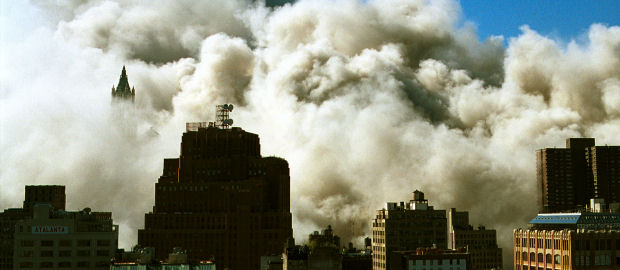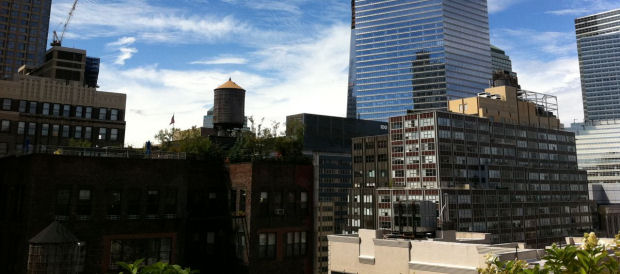9/11: the view from lower Manhattan
Those of us who live in Lower Manhattan don’t need, nor want, much reminding of 9/11, writes former New York Times blog editor Robert Mackey for Channel 4 News.

While the approaching 10th anniversary of the terrorist attacks that killed nearly 2,800 people in and around the World Trade Center in New York in 2001 has brought the awful events of that day back to the minds of many people in the rest of the world who must rarely think about them now, those of us who live in Lower Manhattan don’t need, nor want, much reminding.
From where I write this, I can look out the window of my apartment (the view is pictured, below) and see the new building – once called the Freedom Tower, now known as 1 World Trade Center – already rising 1,000 feet into the air just a few blocks away.
It would be an exaggeration to say that the tower looms, physically, over everything in this part of the city; at least for the moment a new 76-story skyscraper designed by Frank Gehry nearby is higher and more dominant.
But then again, while I rarely find myself noticing how close the planes that fly over this part of the city come to that famous architect’s new building, on many evenings this summer when we’ve gone up to our building’s roof to enjoy the small communal garden, I have wondered, as one jet after another flies not all that far above the new World Trade Center building, if they intend to change the current flight paths when it is finished.

Then too, years after my wife and I first wondered who on earth would be unfortunate enough to be forced to occupy the upper floors of that new office building, knowing what had happened there before, the company she works for recently announced quite proudly that it would become its anchor tenant.
After the announcement, she received a company-wide email describing how excited her employer is to be moving its whole staff into this modern marvel of a building.
That note did not mention that the company will save tens of millions of dollars in rent by agreeing to place its workers at a site attacked twice in the past two decades by terrorists; nor did it point out that the views on one side of the new building will be of the vast memorial to the twin towers that were vaporised in 12 seconds each.
That memorial, centered on the huge, negative spaces that mark the former foundations of the two buildings destroyed on live television a decade ago, will test the human capacity for forgetting to its maximum for the thousands of office workers who will look down on it every work day.
And, of course, the the 9/11 Memorial, which will be dedicated on Sunday and open the next day, will bring a constant, daily stream of tourists to this part of the city, making the act of remembering what happened here in 2001 a vital part of the neighbourhood’s function and economy.
That’s not to say that anything will much change when the official museum opens. For every one of the 10 years since the attacks, even when there was nothing more to be seen than a vast building site, New Yorkers living in this part of town, on their way to work or to school or to buy milk, have been stopped by tourists clutching maps and guide books and asked for directions to Ground Zero.
As someone who visited Cambodia soon after the country’s civil war came to an end, when the nation was only known to most outsiders for one thing, its genocide, and tourist maps were marked with piles of skulls to show the locations of the former school used as a torture centre and of the famous Killing Fields, I now feel a certain kinship with the people who tried to live their lives, to shape their futures, in houses situated so close to those sites devoted to the past.
-
Latest news
-
Year of civil war in Sudan ‘a nightmare of hunger and displacement’4m

-
Israel fears repeat Iran attack, says former editor of Jerusalem Post4m

-
How long could it take to clear the Rwanda asylum seeker backlog?3m

-
Rwanda asylum boost for Sunak as bill expected to become law2m

-
Donald Trump trial: day one of historic Stormy Daniels court case4m

-





